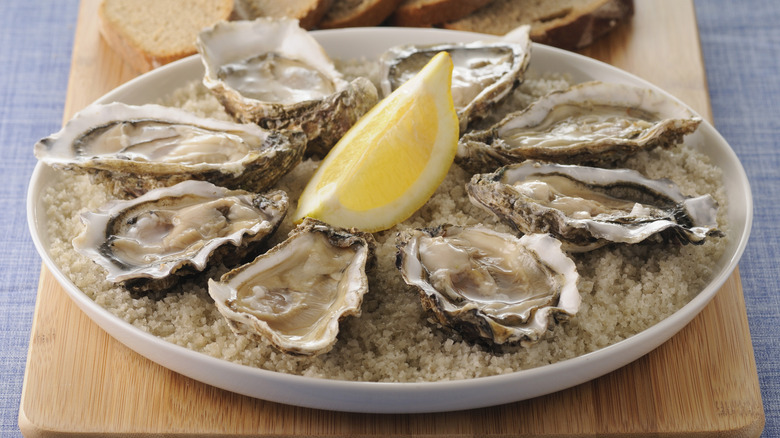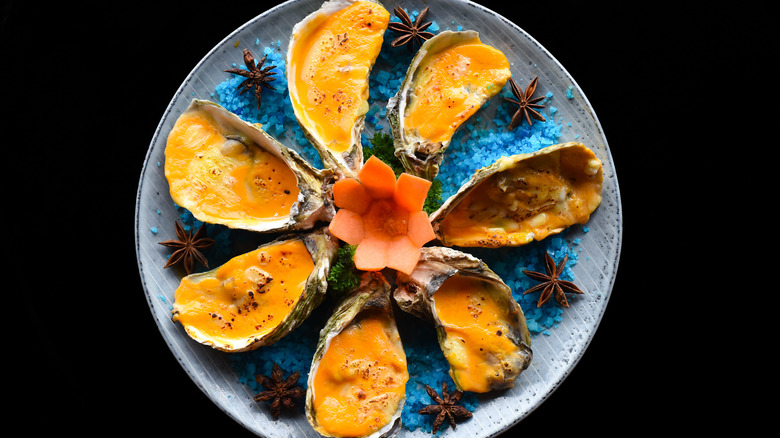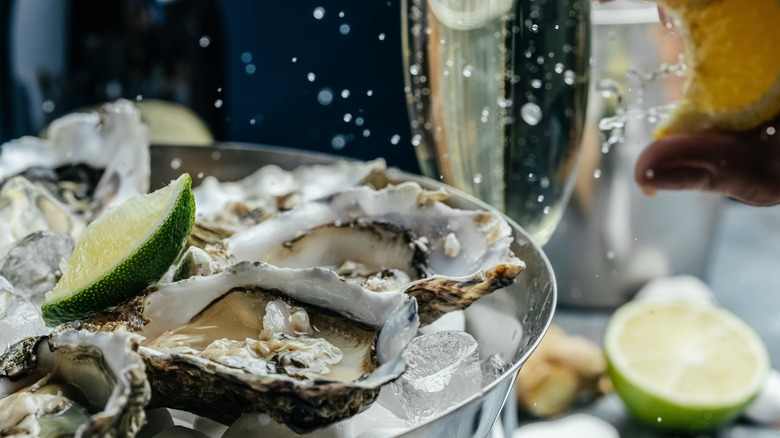The Absolute Best Way To Serve Oysters Is On A Bed Of Salt
What could be more evocative of the sea than a platter of fresh oysters? Well, oysters on a bed of salt, of course. This culinary practice is widespread amongst chefs and caterers, and it involves lining a dish with a layer of coarse salt and nestling the raw or cooked oysters on top. Oysters on a bed of salt offer a beautiful presentation that works with all kinds of preparations. You can use rock salt (which has the most rustic aesthetic), pretty pink Himalayan salt, or artisanal salts like Le Guérande sea salt or Celtic gray salt that evoke damp sand.
Why do this? For starters, it's an easy, restaurant-worthy presentation you can whip up in your home kitchen. But it's also practical. According to Food Network, a layer of heavy salt holds oyster shells in place, keeping them from spilling their precious briny liquor (yup, that's what that juice is called). Not only does the liquor keep the oysters alive and fresh when they're no longer underwater, but it also boosts and protects their raw and cooked flavors (per White Stone Oysters).
How to make a salt bed for oysters
While oysters are incredibly rich in complete protein, omega-3s, vitamin B12, and minerals like zinc, iron, manganese, and selenium (per Healthline), raw oysters can carry potentially harmful bacteria, viruses and chemicals due to their filter-feeding nature, Healthline adds. Cooking eliminates these risks, and many cooked oyster recipes can be attractively served on salt. Plus, Post and Courier adds that when the salt heats up, it helps convey the energy to the whole oysters, enabling them to cook quickly and making them easier to shuck.
AL.com tells us that after you've laid the rock salt and oysters out in a baking pan or skillet, broil them for three minutes, bake them at 450 F for around 10 minutes, or grill them for five minutes. The outlet also shares a recipe for parmesan-garlic baked oysters (also on rock salt) or "Bama Bakes" with local sausage and watercress. Jamie Oliver shares a take on the timeless oysters Rockefeller and elegant cooked oysters with burnt butter. You can even bake oysters on baguette slices, like Marc Murphy. Note that per Seafood Nutrition Partnership, cooked oysters should open up when they're done.
More shore-to-plate recipes
If you'd prefer to brave uncooked oysters, which many consider totally worth any chances of foodborne illness, you can enjoy these beautiful bivalves on their own, savoring the sweet and salty flavors of Pacific and Atlantic varieties. If you're planning to do oysters on the half shell, White Stone Oysters says to wait until just before you're ready to serve to do any shucking, as oysters are prone to spoilage and getting dirty — and always discard unshucked oysters that have opened or have damaged shells. And raw doesn't mean you can't get fancy with it.
Taste.com.au recommends rock salt and savory dressings made with pancetta, tomato, shallots, and chives for uncooked oysters. Use coarse smoked sea salt for Le Creuset's version, which pairs the shellfish with mango, microgreens, herbs, chili, lime, and coconut milk. Le Guérande's recipe features oysters crowned with a shallot vinegar jelly, warming spices, and lemon zest atop their peppercorn-scented coarse grey Guérande sea salt. With their delicious flavor and versatility, oysters are one of nature's finest, healthiest food gifts — do them justice and serve them on a salt bed.


